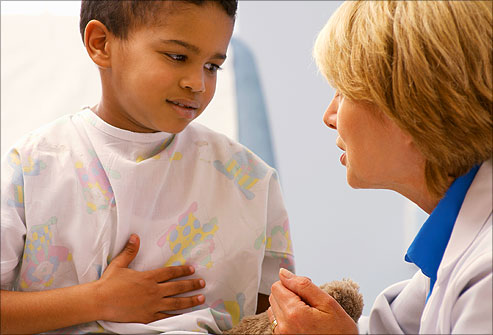 Most young babies throw up all the time during infancy period. In most cases, occasional spitting is considered normal (and responds very well to postural changes), but recurrent episodes of spitting with other disturbing symptoms is mainly due to acid reflux.
Most young babies throw up all the time during infancy period. In most cases, occasional spitting is considered normal (and responds very well to postural changes), but recurrent episodes of spitting with other disturbing symptoms is mainly due to acid reflux.
Ideally, all the stomach contents should move further down into the small intestine, but in some cases, the contents may regurgitate backward causing the acid reflux disease. This can also occur in older children, known asgastroesophageal reflux disease (GERD), and is not a healthy sign of functional digestive function, as it is not just food that moves upwards, but also the acid found in stomach.
How to Recognize Acid Reflux in Children
The hallmark sign of acid reflux in children is dyspepsia or heartburn that is very common in growing adolescents and even in children. The duration of symptoms may last up to two hours at a time and may worsen with food intake. Acid reflux in very young kids may cause disturbing symptoms before and after breastfeeding.
Other common symptoms of acid reflux in children includes:
- Continuous coughing and persistent vomiting after meals.
- Children may find swallowing difficult and may experience abdominal pain in addition to occasional choking of food and breathing problems.
Some uncommon cases of acid reflux in children may lead to gastric colic, improper growth and recurrent pneumonia.
Children between the age of 1 or 2 years may choke up breast milk or milk formulae after being fed; this is commonly referred to as ‘wet burps’. Although in most children wet burps stop after two years, some children suffering from neurological problems (such as cerebral palsy) may continue to face GERD symptoms until adulthood.
It is advised to call a doctor when your child experiences abdominal pain and feels heartburn after his meals. Diagnosis and treatment of GERD at the right time can prevent further complications for your child. Likewise, proper treatment instituted at a younger age can prevent the need of much serious medications and other GERD related complications in the adulthood.
The following video explains more on symptoms of acid reflux as well as possible causes:
What Causes Acid Reflux in Children?
The primary cause of acid reflux in children is the continuous opening of the junction between the stomach and esophagus. Ideally, when food passes down into the stomach, this opening closes to prevent food regurgitation. The problem arises, when this junction remains open during normal breathing and peristaltic movements (rhythmic contractions of gut muscles), to cause reflux of gastric contents.
Some reasons why this opening fails to close include:
- Obesity
- Overfeeding
- Excessive use of carbonated drinks
- Medications
- Slow gastric emptying time
- Something that the mom eats or intolerance of the foods ingested
How to Treat Acid Reflux in Children
Treatment strategies for the management of acid reflux in kids depend on the age and diet of the child and other biological factors:
In Young Babies
In young babies, the best course of action is to introduce a thicker meal (such as breast milk or formula milk mixed with small amounts of rice cereal to make it slightly thicker and resistant to regurgitation).
In Infants
- The doctor would recommend keeping the baby’s head elevated slightly to prevent choking due to regurgitated food particles.
- It is also advised to keep the baby seated in an elevated position for at least half an hour after feeding.
- Thickening the formulae with rice cereals may also help, but it should strictly be done with doctors’ advice.
- Sometimes, changes in the feeding schedule and increase in solid diet may also prove helpful.
In Older Children
Acid reflux in children who are older than 5 years can be avoided by reducing the consumption of acidic food.
- The child must be kept upright for as long as two hours after food intake and the head must be held at an upright angle while eating.
- Reducing the meal portions also proves helpful. Instead of large portions, parents should encourage frequent smaller portions of meal at regular intervals throughout the day.
- Regular exercise is also recommended on daily basis.
- For much older children, avoiding certain types of food such as carbonated drinks, acidic fruits, caffeine, oily and spicy food can prove helpful, as these trigger GERD. Tomatoes, garlic, onions and peppermint may also cause acid reflux.
- In order to prevent acid reflux in kids of older age, the level of head support should be raised by 8 inches.
- Smoking, alcohol consumption and over eating should also be controlled. Avoid smoking in in a room where your kid is present.
- Medications such as proton pump inhibitors, H2 antagonists and antacids may help treat more severe cases of GERD. These pharmacological preparations work by reducing the acid production in stomach, blocking H2 channels and neutralizing the stomach acid respectively. Prokinetics may also be recommended in treatment regimen of acid reflux in kids to allow esophageal sphincter to empty out the stomach contents at a quicker rate. These drugs usually act on the lower esophageal muscles.
Surgical treatment is sought as the last resort, when medications fail to help. Fundoplication, is a procedure in which a small valve is created on the upper side of the stomach. This is done by tying a small portion of the stomach around the esophagus.
